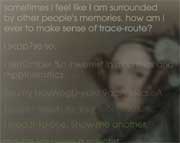ada1852
by Christopher Fahey
http://rhizome.org/ada1852/
|
It is a virtual certainty that in the near future we will hold
conversations with computers as regularly as we do with other human
beings. The more sophisticated these machines are, the more lifelike
they will likely be. But what will these digital personalities be like? In addressing the Rhizome alt.interface project, I thought about how an artificial intelligence might be used to serve as a kind of docent or guide to the Rhizome ArtBase. I did not, however, want to create a slavish "service" robot. I did not want to build a person whose primary function is to be a non-person like a telemarketer following a sales script. What if the AI character had its own story to tell, its own interests and hang ups -- just like real people do? What if the AI had an agenda of its own? The AI is named ada1852, after the person who is widely regarded as the first to write a computer program: Ada Byron, the Countess of Lovelace and the daughter of the poet Lord Byron. Lady Lovelace was one of the first to theorize about machine intelligence, authoring the "Lovelace Objection", which states that machines are not capable of generating ideas for which they were not specifically designed. To me she seemed the ideal candidate to be the first to have her memories and personality "uploaded" into a virtual persona. ada1852 is merged with the Rhizome ArtBase. The digital artworks contained in the ArtBase surround her impaired consciousness and form the world in which she exists. Like Frankenstein's monster, ada1852 is also a troubled soul. Her digital mind is, just as she suspected in her famous objection, unable to be as dynamic and inventive as she once was. She seeks assistance from the user as much as the user seeks assistance from her. ada1852 is based upon AIML, an open-source artificial intelligence system first created by Dr. Richard Wallace. Research and dialogue assistance was provided by Margaret Jameson and Thomas Jameson. Invaluable technical assistance was provided by Paul Rydell, Daniel Han, and the entire ALICE/AIML community. Thanks also to Mark Tribe, Alex Galloway, and Francis Hwang at Rhizome.org. Bio Christopher Fahey has been making computer games and graphics since childhood, and he continues to experiment with new ideas in computer art and design. He is the creative force behind the online laboratories graphpaper.com and askrom.com. Christopher is a founding partner of Behavior, a New York-based interaction design firm, where he serves as the Information Architecture practice lead. He has led many interactive productions as an art director, game designer, interface designer, and information architect. He is also currently teaching web art and design in the Art Department at Brooklyn College. Christopher graduated from the Cooper Union School of Art in 1993 with a focus on interactive sculptures and installations, and has worked in the new media business ever since. |
 |
